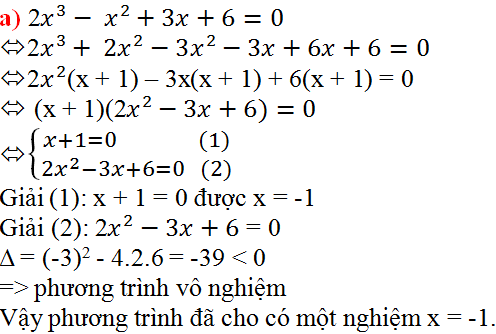Hãy nhập câu hỏi của bạn vào đây, nếu là tài khoản VIP, bạn sẽ được ưu tiên trả lời.

a. \(2x^3-x^2+3x+6=0\)
\(\Leftrightarrow2x^3+2x^2-3x^2-3x+6x+6=0\)
\(\Leftrightarrow2x^2\left(x+1\right)-3x\left(x+1\right)+6\left(x+1\right)=0\)
\(\Leftrightarrow\left(x+1\right)\left(2x^2-3x+6\right)=0\)
\(\Leftrightarrow x+1=0\) ( vì \(2x^2-3x+6\) > 0 với mọi x)
\(\Leftrightarrow x=-1\)
Vậy tập nghiệm của pt là \(S=\left\{-1\right\}\).
b. \(x\left(x+1\right)\left(x+4\right)\left(x+5\right)=12\)
\(\Leftrightarrow\left(x^2+5x\right)\left(x^2+5x+4\right)=12\)(1)
Đặt \(x^2+5x=a\) . Khi đó pt (1) trở thành :
\(a\left(a+4\right)=12\)
\(\Leftrightarrow a^2+4a-12=0\)
\(\Leftrightarrow\left(a-2\right)\left(a+6\right)=0\)
\(\Leftrightarrow\left[{}\begin{matrix}a-2=0\\a+6=0\end{matrix}\right.\Leftrightarrow\left[{}\begin{matrix}a=2\\a=-6\end{matrix}\right.\)
* Với a = 2 thì \(x^2+5x=2\Leftrightarrow x^2+5x-2=0\) \(\Leftrightarrow\left[{}\begin{matrix}x=\dfrac{-5+\sqrt{33}}{2}\\x=\dfrac{-5-\sqrt{33}}{2}\end{matrix}\right.\)
* Với a = -6 thì \(x^2+5x=-6\Leftrightarrow x^2+5x+6=0\Leftrightarrow\left(x+2\right)\left(x+3\right)=0\)
\(\Leftrightarrow\left[{}\begin{matrix}x+2=0\\x+3=0\end{matrix}\right.\Leftrightarrow\left[{}\begin{matrix}x=-2\\x=-3\end{matrix}\right.\)
Vậy tập nghiệm của pt là \(S=\left\{\dfrac{-5+\sqrt{33}}{2};\dfrac{-5-\sqrt{33}}{2};-2;-3\right\}\)


\(a,\) Đặt \(x^2+2x=a\), pt trở thành:
\(a^2-3a+2=0\\ \Leftrightarrow\left[{}\begin{matrix}a=1\\a=2\end{matrix}\right.\Leftrightarrow\left[{}\begin{matrix}x^2+2x-1=0\left(1\right)\\x^2+2x-2=0\left(2\right)\end{matrix}\right.\)
\(\left[{}\begin{matrix}\Delta\left(1\right)=4+4=8\\\Delta\left(2\right)=4+8=12\end{matrix}\right.\Leftrightarrow\left[{}\begin{matrix}\left[{}\begin{matrix}x=\dfrac{-2-\sqrt{8}}{2}\\x=\dfrac{-2+\sqrt{8}}{2}\end{matrix}\right.\\\left[{}\begin{matrix}x=\dfrac{-2-\sqrt{12}}{2}\\x=\dfrac{-2+\sqrt{12}}{2}\end{matrix}\right.\end{matrix}\right.\\ \Leftrightarrow\left[{}\begin{matrix}x=-1-\sqrt{2}\\x=-1+\sqrt{2}\\x=-1-\sqrt{3}\\x=-1+\sqrt{3}\end{matrix}\right.\)
\(b,\) Đặt \(x^2+x=b\), pt trở thành:
\(b\left(b+1\right)-6=0\\ \Leftrightarrow b^2+b-6=0\\ \Leftrightarrow\left[{}\begin{matrix}b=2\\b=-3\end{matrix}\right.\Leftrightarrow\left[{}\begin{matrix}x^2+x-2=0\\x^2+x+3=0\end{matrix}\right.\\ \Leftrightarrow\left[{}\begin{matrix}\left[{}\begin{matrix}x=1\\x=-2\end{matrix}\right.\\x\in\varnothing\left[x^2+x+3=\left(x+\dfrac{1}{2}\right)^2+\dfrac{11}{4}>0\right]\end{matrix}\right.\\ \Leftrightarrow\left[{}\begin{matrix}x=1\\x=-2\end{matrix}\right.\)
\(d,x^4-2x^3+x=2\\ \Leftrightarrow x^4-2x^3+x-2=0\\\Leftrightarrow\left(x^3+1\right)\left(x-2\right)=0 \\ \Leftrightarrow\left(x+1\right)\left(x-2\right)\left(x^2+x+1\right)=0\\ \Leftrightarrow\left[{}\begin{matrix}x=-1\\x=2\\x^2+x+1=0\end{matrix}\right.\Leftrightarrow\left[{}\begin{matrix}x=-1\\x=2\\x\in\varnothing\left[x^2+x+1=\left(x+\dfrac{1}{2}\right)^2+\dfrac{3}{4}>0\right]\end{matrix}\right.\\ \Leftrightarrow\left[{}\begin{matrix}x=-1\\x=2\end{matrix}\right.\)
Lời giải:
a.
PT $\Leftrightarrow (x^2+2x)^2-(x^2+2x)-2[(x^2+2x)-1]=0$
$\Leftrightarrow (x^2+2x)(x^2+2x-1)-2(x^2+2x-1)=0$
$\Leftrightarrow (x^2+2x-1)(x^2+2x-2)=0$
$\Leftrightarrow x^2+2x-1=0$ hoặc $x^2+2x-2=0$
$\Leftrightarrow x=-1\pm \sqrt{2}$ hoặc $x=-1\pm \sqrt{3}$
b.
PT $\Leftrightarrow (x^2+x)^2+(x^2+x)-6=0$
$\Leftrightarrow (x^2+x)^2-2(x^2+x)+3(x^2+x)-6=0$
$\Leftrightarrow (x^2+x)(x^2+x-2)+3(x^2+x-2)=0$
$\Leftrightarrow (x^2+x-2)(x^2+x+3)=0$
$\Leftrightarrow x^2+x-2=0$ (chọn) hoặc $x^2+x+3=0$ (loại do $x^2+x+3=(x+0,5)^2+2,75>0$)
$\Leftrightarrow x=-1\pm \sqrt{3}$
c. Nghiệm khá xấu. Bạn coi lại đề.
d.
PT $\Leftrightarrow x^3(x-2)+(x-2)=0$
$\Leftrightarrow (x^3+1)(x-2)=0$
$\Leftrightarrow x^3+1=0$ hoặc $x-2=0$
$\Leftrightarrow x=-1$ hoặc $x=2$

a) \(x-2=0\Leftrightarrow x=2\)
b) \(x^2-2x=0\Leftrightarrow x\left(x-2\right)=0\Leftrightarrow\left[{}\begin{matrix}x=0\\x=2\end{matrix}\right.\)
e) \(2x^2+5x+3=0\Leftrightarrow\left(2x+3\right)\left(x+1\right)=0\Leftrightarrow\left[{}\begin{matrix}x=-\dfrac{3}{2}\\x=-1\end{matrix}\right.\)
f) \(x^2-x-12=0\Leftrightarrow\left(x-4\right)\left(x+3\right)=0\Leftrightarrow\left[{}\begin{matrix}x=4\\x=-3\end{matrix}\right.\)

b) x.(x+1). ( x+ 4). (x+ 5) = 12
⇔ [ x. (x + 5)]. [(x+1). (x+ 4)] = 12
⇔ x 2 + 5 x ⋅ x 2 + 4 x + x + 4 − 12 = 0 ⇔ x 2 + 5 x ⋅ x 2 + 5 x + 4 − 12 = 0 ( * )
Đặt t = x 2 + 5 x + 2
= > x 2 + 5 x = t – 2 v à x 2 + 5 x + 4 = t + 2
Khi đó phương trình (*) trở thành:
( t – 2). (t+ 2) - 12 = 0
⇔ t 2 − 4 − 12 = 0 ⇔ t 2 − 16 = 0 ⇔ t 2 = 16 ⇔ t = ± 4
+ Với t = 4 ta có: x 2 + 5 x + 2 = 4
⇔ x 2 + 5 x – 2 = 0 ( * * )
Có a= 1, b = 5, c = - 2 và ∆ = 5 2 – 4 . 1 . ( - 2 ) = 33 > 0
Nên (**) có 2 nghiệm phân biệt là:
* Với t = - 4 ta có: x 2 + 5 x + 2 = - 4
⇔ x 2 + 5 x + 6 = 0 ( * * * )
Có a= 1, b = 5, c= 6 và ∆ = 5 2 – 4 . 1 . 6 = 1 > 0
Phương trình (***) có 2 nghiệm là:
Vậy tập nghiệm của phương trình đã cho là: